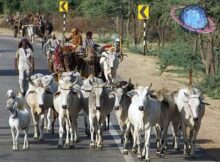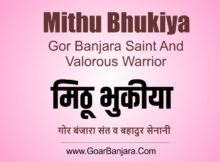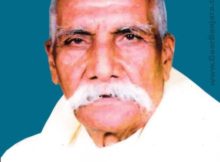[4] Religious literature: The kings were referred to as Maharaja in the Buddha period. Today the Dhalias while saluting the Naiks proclaim them as ‘Maharaj.’ Naik in turn offers them some donations for entertainment.
[5] Folk Literature: Folk lores, legends, Saki, Kelawat, proverbs, rituals at the time of birth, marriage and death etc. all provide references about the Gor kings.
[6] Foreign Travelers: Chinese traveler Hun-en-Tsang has mentioned about Gor kings. Two Portuguese travelers, who visited India in 16th century, have mentioned in their Bakhar about Vijayanagar Empire about the traders with thousands of oxen laden with goods. These traders might be the Gors.
[7] Independent Dialect: The independent dialect of a tribe cannot be created till the tribe does not live in a single region for about 300 years. Gor dialect is an independent dialect of the Gors. This dialect flourished under their rulers. Due to the efforts of Vasantrao Naik the Gor community in Yevatmal district now speaks the dialect.
[8] Other historical references: Gorvamshiya’s trade in the Greek period was spread from Afghanistan to Malawa province. Diga Naik Majma Naik was ruling in the Malawa province. Naresh Singran in Maurya’s time was a Gorvamshiya. The famous king Alexander’s daughter’s friend was a Gor girl. Research may reveal the similarity between the ancient Greek culture and Gor culture. The tragedy of Greek King Oedipus Rex is still a part of the Gor literature. Does this mean that the Gor culture was named as Greek culture? It is a challenge to the researchers. These entire historical criterions are fulfilled by the Gors.
The unknown history of the Gors has come to light now. It was unknown according to Indian historians. Even the Gor Banjaras were ignorant about their original history. The Gor Banjaras were considering themselves of Rajput clan due to ignorance. They have also taken up surnames like Rathod, Pawar, Chavan and Jadhav. These are not the surnames of Gorvamshiyas. Their clans are different. e.g. in Rathores it is Ramawat, in Jadhav it is Vadatiya, in Chavan it is Mud while in Pawar it is Palthya. Almost 2000 clans belong to Pada Khap.
The Rajput dynasty is basically originated from Shak Hun. The reference about Rajput dynasty is found after 9th Century only. Earlier it was not in existence. In this way the history of Gor dates back to minimum 3 thousand years and maximum 7 thousand years.
Alha Udal
The Samat of Gor kingdom Mahoba, Alha Udal fought from Parmal King’s side and against Prithviraj Chauhan in 1182. The Chauvan’s army was frustrated due to the bravery of Udal. He did not spare Prithviraj even. Udal caught Prithviraj in this battle. Kavi Chand Bardai Bhat mediated for the release of Chavan. In the end Alha Udal became martyr in this war. The heroic attitude of Udal is still remembered by the Gors in Central Province through songs. It is said that Udal was blessed by Waghai (Jagdamba). She has given 5 horses to him. Whoever would ride the horses was blessed against death. Alha Udal was ruling in Mahoba region.
King Parmal asked for the 5 horses from him. Udal declined the demand. In the end he left the King Parmal and went to King Jaichand. Reference has been found that Alha Udal won number of battles due to the love and insistence of King Parmal’s wife (Bundelkhand Ki Sanskriti Aur Sahitya, page 2). One more reference in the book Khajuraho Lokkatha Se Itihaas says: “Alha Udal was brave warrior of Vindhya region. His nephew Sardar Malkhan was ruling in Sinhalgad (Omkar Sahi, page 29).
Lawan Prasad Veerdhaval Gor
Wanik Gors were chief in the court of Chalukya King Bhimsingh IInd during 1178-1241 AD. They later on became ministers. He was well known for his political skills. As a minister he handled the governance for almost 24 years. He number of times subsided the revolt against the state and he was skilled to work together with all concerned (Devgiri Ke Yadav, by Dr. Rajmal Bora, page 29). It proves that Gors were kings and administrations at number of places.
Samant Gora-Badal
In the story of Rajput King Rattan Sen, Queen Padmini and Allauddin Khilji, Gorvamshiya soldier Gora and Badal’s bravery is famous among Gor Banjaras. Gora and Badal were uncle and nephew in relation. In the collection of Pundit Gaurishankar Oza there is a reference on page 87: “ One soldier used to handle hundreds of Shakas in a day.” A fort is built in his memory. It is called as Gorshring. Oza further says: “The word Gor is not individual but suggestive of a clan.” Gora and Badal were chiefs of Kshatriya Gorvamshi army. When King Rattansen was arrested Queen Padmini went to Gora-Badal’s house for consultation (Rajasthani Puratan Granthmala, page 37). A parallel reference is found in epoch poem Padmavat of Jayasi, which is a dialogue between Padmavati and Gora-Badal:
“आगलि गोरु बेटू दिटी तब तसु न येणे अमिय पयह गोरई दिढी, ढडीजब पद्मणी हर्षीत हुयी”
Gora was 12 years old then. Padmini and Gora changed their drapery. A fierce battle erupted. Gora and Badal were killed in this battle. Two memorials have been erected in their memory on Chittorgarh near Padmini Palace. It is called as Gora-Badal palace. Banjara tribe fondly remembers the heroic acts of Gora and Badal (Udaipurka Itihaas, Part II by Gopinath Sharma, page 193).
Samant Jaymal and Fatta Chudawat
Gorvamshiya Samants ruled in the mountain range of Udaipur. They fought against the Mughals as chief of armies or kings. Emperor Akbar tried to appoint Gors in his country but he failed. They did not make even matrimonial relations with them. Jaymal Rathod and Fatmal Chudawat was the army chief in the court of King Udaysingh. When Akbar attacked Udaipur in 1567, King Udaysingh fled in the jungles. He had handed over all governance to Chudawat and Jaymal. Gorvamshiya fought the fort for 3 months.
In the end they died while fighting. Emperor Akbar was also impressed by their performance. He erected a memorial near Chittorgarh in their memory (Rajasthan Ka Itihaas by B.L. Pangadia, page 13). A poetic reference to these two men is found in the book ‘Gor Banjara Lokancha Itihaas by Baliram Patil, page 13.
भुकिया तु जगेमा छु किची मोठो चितौड गडेप वक्त आया जना कत गेतो जयमल फतमल वेगे सताविसेन सात
Gor in South India
Reference about Gor Banjaras venturing in whole South India is found. According to Ashraf Khan’s ‘Dakshin Bharat’: “In the regime of Krishna Devarai in South India every thing was brought in Vijaynagar laden on the oxen. Daily 2 thousand oxen used to enter the gates of Vijayanagar with goods laden on them” (page 297). In general, South Rajasthan, North Madhya Pradesh and North East part of Gujarat was under the rule of Gor kings.
As per availability of fodder and water for the cattle they used to practice agriculture on Malawa plateau and mountain regions of Nimadi for many years. They used to travel for 8 months for trade and goods transport and return to their original Tandas in the rainy season. The Tandas never used to move with all women and children (Maharashtra Volume I by Chintamani Karve, page 628). During the regime of Prithviraj Chavan the next of kin of Alha Udal went to Kajari forest to live along with their Tandas.
The Tandas stopped at the southern feet of South Vindhya. They started practicing agriculture on a large scale. Deola Naik was looking after the governance of 10 villages in Udaipur while fighting with the Moguls. Some of the Tandas were destroyed when Pathans captured the Malawa province in 1546. The Tanda of Naik Kripalsingh Gor reached Vindhyas with lakhs of Oxen in 1668 (Banka Bol Bundelkhand by Kailash Madwaiya, page 75). The transport business of Gor Banjaras became important during the 15th to 17th Century. Provision of materials to the armies became their monopoly business.
They were known for their honesty. According to Mr. Henry Elliot, Gor Banjaras were adopting honest trade practices hence the Mughal Kings had full faith in them (Rajasthan Ki Jatiya by Bajranglal Lohia, page 167). A reference in the book ‘Rajasthan’ by Dharam Pal says that Banjaras were engaged in the trade of transport of goods for many centuries. During the Mughal period their armies needed to halt for many days at a place due to shortage of oxen to carry the material (page 40).
Some of the Gor Tandas among the Kshatriya Rajvamshiya Gor proved their mettle in the transport business in the country. Only one class i.e. Kshatriya Vaishya was present in the Gupta period. They were engaged both in war and trade. Gor Banjaras are also engaged in these two occupations since the Gupta period.
Supplying goods to Army
The Vazeer of Shahjahan, Asharaf Khan took the Banjaras from Bundi Kota region to supply essentials to Mughal army in the south around 1630 (The Army of Indian Mughal, Dr. Asharaf, page 230). Jangi-Bhangi Rathod and Bhagwandas Wadatiya first came to south India with the army. Jangi-Bhangi had 1 lakh 80 thousand oxen with them. While Bhagwandas Wadatia had 52 thousand oxen. Considering their ability of transport they were regarded with high esteem in the mughal court.
They were presented with a Copper Place (Tamrapatra) on which following words were written:
रंजन का पानी,छप्पर का घास,दिन में तीन खुन माफ जहाँ असरफ खान के घोडे,वहाँजंगी भंगी के बैल खडे
Except Marathwada and Khandesh in Vidarbha all Gor Banjaras in Andhra Pradesh and Karnataka are descendents of Jangi-Bhangi and Bhagwandas Wadatiya. Considering the honour, money, forest area for the food for cattle number of Tandas gradually migrated to south India from Central Province.
They did not return to Bundi Kota region again. When the Railway became operational in 1896, their traditional business was gradually closed down. Some Tandas started practice of agriculture on large scale, country liquor, stealing wood from jungles and other big things.
The British made a Criminal Tribes Law in 1871 and branded this tribe as criminal. The legal oppression of Gor Banjaras started. The law eroded their life in totality. In 1952 Dr. Babasaheb Ambedkar as a law minister modified the Criminal Tribes Act but the law was not abolished completely. Its ill effects are still faced by the Banjaras.









